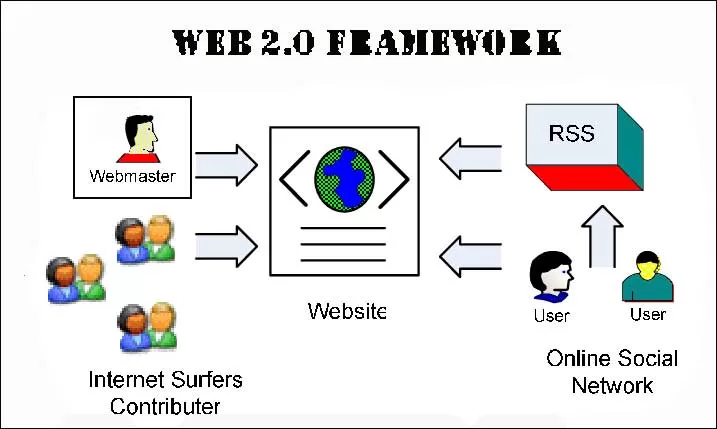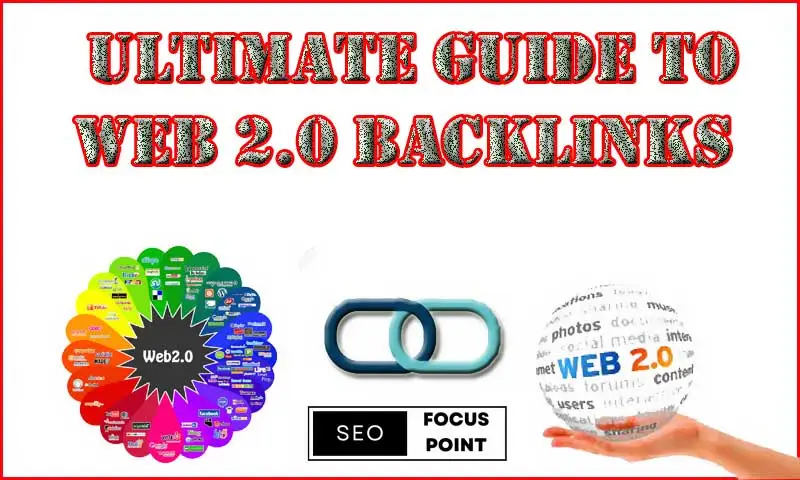Welcome to the “Ultimate Guide to Web 2.0 Backlinks: 200+ Free High DA Sites for 2023.” In this comprehensive guide, we will delve into the world of Web 2.0 backlinks and explore how they can significantly impact your website’s SEO and organic search rankings.
If you’re looking to improve your website’s visibility, attract more organic traffic, and boost your search engine rankings, then understanding and utilizing Web 2.0 backlinks is essential. Backlinks from high Domain Authority (DA) Web 2.0 platforms can be powerful assets in your SEO arsenal, driving relevant traffic to your site and signaling search engines that your content is valuable and trustworthy.
In this guide, we’ll take you on a journey to explore the concept of Web 2.0 backlinks, its importance in the ever-changing landscape of SEO, and how you can effectively build a diverse and natural backlink profile to enhance your online presence.
Table of Contents
What are Web 2.0 Backlinks?
Web 2.0 backlinks refer to hyperlinks pointing to a website from user-generated content platforms known as Web 2.0 sites. These platforms allow users to create and publish content, making them an excellent source for building backlinks to boost a website’s search engine rankings and overall online visibility.

During the early days of the internet, most websites were static, with limited opportunities for user interaction and content creation. However, with the advent of Web 2.0 technology, the internet landscape evolved into a more dynamic and collaborative space. Web 2.0 platforms emerged, enabling users to actively participate, create, and share content with others.
Are Web 2.0 Sites Good for SEO?
Web 2.0 sites are considered beneficial for SEO (Search Engine Optimization) to some extent. Web 2.0 refers to websites and applications that allow user-generated content and interactivity, creating an environment for collaboration and sharing. Web 2.0 mainly article submission sites. You can post your content there. Besides SEO this type of website allows for your content marketing.
The benefits of using Web 2.0 sites and Web 2.0 Backlinks for SEO were primarily related to backlink building and content distribution. Here’s how they could be helpful:
- Backlinks: Many Web 2.0 sites allow users to create content with backlinks to their own websites. By creating high-quality content on these platforms and linking back to your main website, you could gain valuable backlinks. Backlinks from reputable and relevant sources can positively impact your website’s search engine rankings.
- Diversification: A diverse backlink profile is considered favorable by search engines. Using Web 2.0 platforms for backlink building can be one way to diversify your link profile, especially when combined with other link-building strategies.
- Exposure and Traffic: Web 2.0 Backlinks often have significant traffic and user engagement. If your content on these platforms gains popularity, it can drive additional traffic to your website and potentially improve your overall online visibility.
However, it’s important to be cautious and use Web 2.0 sites responsibly for SEO purposes. Google and other search engines continuously evolve their algorithms to provide the best and most relevant results to users. They frown upon manipulative practices and low-quality content.
Here are some important points to consider:
- Quality of Content: Focus on creating high-quality, valuable, and relevant content that genuinely adds value to users. Avoid spammy or low-quality content, as it can harm your SEO efforts.
- Relevance: Ensure that the content you create on Web 2.0 sites is related to your main website’s niche or topic. Irrelevant links may not be as effective and could even be considered spam.
- Natural Linking: When placing backlinks, do it in a way that appears natural and not as if you’re trying to manipulate search engine rankings. Over-optimization and keyword stuffing should be avoided.
- Diversity: While using Web 2.0 sites can be beneficial, don’t solely rely on them for your SEO strategy. Diversify your efforts by combining various link-building methods and SEO techniques.
Keep in mind that SEO is a complex and ever-changing field. What might be considered effective today could change tomorrow as search engines update their algorithms. To stay up-to-date with the latest SEO best practices, it’s essential to follow reputable SEO blogs, forums, and industry experts.
Always prioritize creating a positive user experience and providing valuable content, both on your main website and any other platforms you utilize. SEO efforts should be part of a broader strategy to attract and engage users, rather than just chasing search engine rankings.
Advantages and Disadvantages of Web 2.0 Backlinks
Web 2.0 backlinks, which are links pointing to your website from user-generated content on Web 2.0 platforms, have both advantages and disadvantages when used for SEO purposes. Let’s explore them:
Advantages of Web 2.0 Backlinks:
- Link Diversity: Web 2.0 backlinks provide an opportunity to diversify your link profile. Having links from a variety of sources can signal to search engines that your website is relevant and valuable.
- Ease of Creation: Creating content on Web 2.0 platforms is often straightforward and doesn’t require extensive technical knowledge. This makes it accessible for a wide range of users to engage in link building.
- Traffic Generation: Popular Web 2.0 sites often have a large user base, and if your content gains traction, it can lead to increased traffic to your main website by building high-quality Web 2.0 Backlinks.
- Brand Exposure: Posting content on various platforms can increase your brand’s visibility and exposure to a wider audience.
- Backlink Control: Since you create the content on Web 2.0 sites, you have some control over the anchor text and the context of the backlink, allowing you to optimize them for SEO.
Disadvantages of Web 2.0 Backlinks:
- Quality Concerns: Web 2.0 sites are open to user-generated content, which means the quality of content can vary significantly. Poorly written or irrelevant content can harm your website’s reputation and SEO efforts.
- Risk of Penalties: If you engage in spammy or manipulative practices on Web 2.0 platforms, it could lead to penalties from search engines. Google, in particular, penalizes websites that participate in link schemes or spammy Web 2.0 Backlinks.
- Limited Authority: While some Web 2.0 sites are reputable, many others lack authority and trustworthiness in the eyes of search engines. Backlinks from low-quality platforms may not provide significant SEO value.
- Platform Control: Since you don’t own Web 2.0 sites, you are at the mercy of the platform’s policies. They can modify or delete your content or links at any time, potentially affecting your SEO strategy.
- Time-Consuming: Managing multiple Web 2.0 accounts and creating content for each platform can be time-consuming. It may require considerable effort to make this approach scalable and effective.
- Diminishing Impact: Over the years, the influence of Web 2.0 backlinks on search engine rankings has diminished due to algorithm updates and increased emphasis on other ranking factors.
It’s important to approach Web 2.0 backlinks with a focus on quality and relevance. Using them as a part of a diversified link-building strategy, along with other reputable and authoritative link sources, can be more beneficial for your SEO efforts. Remember that the ultimate goal is to provide value to users through quality content and natural link-building.
Free web 2.0 High DA Backlinks Sites List
Over 200+ Free web 2.0 High DA Backlinks sites, Famous websites are as follows:
 WordPress.com
WordPress.com
WordPress.com is a user-friendly blogging platform that allows users to create and host blogs for free. It offers a wide range of customizable themes and plugins, making it a popular choice for bloggers of all levels of expertise. Its Domain Authority is 93, which is very high. But you should keep in mind you as a free user and due to the subdomain, SEO value from the main domain will not pass through your backlinks. we will be benefited if the Page Authority (PA) of your home page should be high. You can easily increase your Web 2.0 PA. We will discuss the method later.
 Blogger (blogspot.com)
Blogger (blogspot.com)
Blogger, powered by Google, is a straightforward blogging platform that allows users to create and manage blogs with ease. It offers integration with other Google services and is known for its simplicity. Your blog address will be domain.blogspot.com. This platform will allow you to create a custom design with various Free Templates & you can create your own in HTML & CSS. Blogger does not support PHP or another advanced programming language. If you give some effort into your blog, design it better, and post regularly, you can enrich your backlinks from the blogger blog. It will give you full SEO value.
On the other hand, if think I will create lots of blogs and create backlinks, which will increase my number of referring domains. You are in a spammy procedure and due to these spammy backlinks, your website will be penalized by Google. So, my recommendation is to increase your DA and post unique content regularly then create backlinks to your main website.
 Tumblr
Tumblr
Tumblr is a social media platform and microblogging website that allows users to post and share multimedia content, such as text, images, videos, and GIFs. It was founded in 2007 by David Karp and was acquired by Yahoo in 2013. Later, in 2017, Yahoo was acquired by Verizon Communications, making Tumblr part of the Verizon Media Group.
One of the key features of Tumblr is its dashboard, where users can follow other users and see their posts appear in a chronological feed. Users can “reblog” posts from others onto their own blogs, effectively sharing the content with their followers. This reblogging feature allows for content to go viral and spread across the platform.
Tumblr has been known for its creative and diverse user base, with communities forming around various interests, including art, photography, fandoms, literature, social justice, and many others. The platform has been particularly popular among young adults and artists, and it has been used as a platform for self-expression, activism, and creativity.
Over the years, Tumblr has faced some controversies and challenges, including issues related to content moderation, adult content, and hate speech. In December 2018, Tumblr made a significant policy change and banned all adult content on the platform, which led to a decline in user engagement and traffic.
 Medium
Medium
Medium is an online publishing platform that was founded in 2012 by Evan Williams, one of the co-founders of Twitter. It is designed as a space for writers, bloggers, and experts to share their ideas and stories with a broader audience. Medium aims to provide a clean, user-friendly interface that focuses on the content and reading experience.
On Medium, users can write and publish articles on a wide range of topics, including technology, science, culture, politics, self-improvement, and more. The platform allows writers to reach a larger audience, as articles published on Medium can be discovered and read by other users who follow similar interests or topics.
Medium operates on a freemium model, where users can read a limited number of articles for free each month. To access unlimited articles and additional features, such as audio versions of stories, users can choose to become Medium members, paying a monthly or annual subscription fee.
One of the unique aspects of Medium is its “clap” feature, which allows readers to show appreciation for an article by giving it “claps.” These claps serve as a form of feedback and also influence how much revenue the author can earn from the Medium Partner Program, which shares a portion of subscription revenue with writers based on the engagement their articles receive.
Medium also has a partner program that allows writers to earn money from their articles based on the number of claps and the reading time their stories accumulate. Authors who participate in the program and meet certain criteria can be eligible for earnings through the Medium Partner Program.
Overall, Medium has become a popular platform for both established writers and aspiring authors to share their thoughts and connect with a wider audience, fostering a community of engaged readers and content creators.
Keep in mind that developments may have occurred after my last update in September 2021, so it’s a good idea to check for any recent changes or updates to Medium’s features and policies.
Weebly
Weebly is a versatile website builder that enables users to create websites with a drag-and-drop interface. It offers various templates and is suitable for personal portfolios, blogs, and e-commerce stores.
Wix
Wix is a popular website builder known for its user-friendly interface and flexibility. It provides a wide range of templates and customization options, making it easy to create visually stunning websites.
Jimdo
Jimdo is a user-friendly website builder that emphasizes simplicity. It offers modern templates and allows users to customize their sites with ease, making it suitable for small businesses and personal websites.
Quora
Quora is a question-and-answer platform where users can ask and answer questions on various topics. It has a large community of experts and enthusiasts, making it a valuable resource for knowledge-sharing.
LiveJournal
LiveJournal is one of the oldest blogging platforms, with a focus on social networking features. It allows users to connect with others through communities and follow each other’s journals.
HubPages
HubPages is an online publishing platform that enables users to create in-depth articles on various subjects. It offers revenue-sharing opportunities through ads and has an active community of writers.
Evernote
Evernote is a popular note-taking app that syncs across multiple devices. Users can save text, images, audio, and web clippings to organize their thoughts and ideas effectively.
Strikingly
Strikingly is a website builder designed for creating one-page websites that are visually appealing and mobile-responsive. It’s suitable for personal portfolios, startups, and small businesses.
Penzu
Penzu is an online diary or journaling platform that emphasizes privacy and security. It allows users to write and store personal entries with ease.
Yola
Yola is a website builder that offers templates and tools to create and host websites. It provides an intuitive interface for users without technical expertise.
Ghost
Ghost is a blogging platform designed for simplicity and speed. It focuses on writing and content creation, making it suitable for bloggers who prefer a distraction-free environment.
Edublogs
Edublogs is a blogging platform tailored for educators and students in the education sector. It offers features such as classroom management and collaboration tools.
Soup.io
Soup.io is a microblogging platform where users can share various types of content, including text, images, videos, and quotes.
Postach.io
Postach.io allows users to create blogs using their Evernote notes. It seamlessly converts notes into blog posts, making it easy for Evernote users to publish content.
Jigsy
Jigsy is a website builder that enables users to create websites and online stores with a range of customization options.
Webnode
Webnode is a website builder that offers templates and a user-friendly interface for creating websites. It allows users to create multilingual websites with ease.
Each platform has its unique features and strengths, catering to different needs and preferences of users. When using these platforms, ensure that your content aligns with their guidelines and policies, and prioritize providing value to your audience.
Guide to Web 2.0 Backlinks
Building web 2.0 backlinks can be an effective way to improve your website’s search engine ranking and increase organic traffic. Web 2.0 sites are platforms that allow users to create and share content, and they often have high domain authority, making them valuable sources for backlinks. Here’s a step-by-step guide to building Web 2.0 backlinks:
Step 1
Understand Web 2.0 Backlinks Web 2.0 backlinks are links from content created on various Web 2.0 platforms like WordPress.com, Blogger, Tumblr, Weebly, etc. These platforms typically have a strong domain authority and can pass link juice to your website, thereby improving its ranking.
Step 2
Choose Relevant Web 2.0 Platforms Select high-authority Web 2.0 platforms that are relevant to your niche or industry. It’s essential to create content that aligns with the topic of your website to make the backlink appear natural and relevant to search engines.
Step 3
Create High-Quality Content The key to successful web 2.0 backlinking is to produce high-quality and engaging content. This will attract more readers, increase the chances of your content being shared, and make your link more valuable to search engines.
Step 4
Register and Set Up Accounts Sign up for accounts on the chosen Web 2.0 platforms. Use a consistent username and profile picture across all platforms for branding purposes.
Step 5
Optimize the Profile Fill out your profile information with relevant details about your website or business. Include a short bio and link back to your website where appropriate. Some platforms allow you to include a link in the profile itself.
Step 6
Create and Publish Content Start creating content on each web 2.0 platform. This could be in the form of blog posts, articles, infographics, or videos. Make sure the content is valuable, well-written, and properly formatted.
Step 7
Incorporate Anchor Texts In some of your content, include anchor text that links back to relevant pages on your website. Use both exact match and diversified anchor text to maintain a natural backlink profile.
Step 8
Interlinking Web 2.0 Properties Where applicable, interlink your Web 2.0 properties to create a network of backlinks that can boost each other’s authority.
Step 9
Promote and Share After publishing your content on Web 2.0 platforms, promote and share it on social media, forums, and other relevant channels to increase its visibility and reach.
Step 10
Monitor and Maintain Regularly check your web 2.0 properties to ensure they are live and functioning correctly. Respond to comments and engage with your audience to build credibility and trust.
Major challenges of building Web 2.0 Backlinks
While web 2.0 backlinks can be a valuable part of your link-building strategy, they come with several challenges that you need to be aware of:
- Platform Policies and Deletion: Web 2.0 platforms often have strict policies regarding promotional content and spam. If your content is deemed to be in violation of these policies, it may be deleted, and your backlink will be lost.
- Quality and Relevance: Creating high-quality and relevant content on Web 2.0 platforms can be time-consuming. Without valuable content, your backlinks may not be as effective, and search engines may not consider them authoritative.
- Link Value and Authority: While web 2.0 platforms have reasonably high domain authority, their link value is generally lower compared to editorial, contextual backlinks from authoritative websites.
- Limited Control: You have limited control over the Web 2.0 platforms. Changes to their policies or algorithms could impact the visibility or effectiveness of your backlinks.
- Competition and Saturation: Popular web 2.0 platforms are often saturated with content, making it challenging to stand out and gain visibility for your backlinks.
- Spam and Overuse: Some SEO practitioners may misuse web 2.0 platforms for spammy link-building practices, leading search engines to devalue these links over time.
- Link Sustainability: Web 2.0 platforms might not have a long lifespan, and your backlinks could disappear if the platform shuts down or changes its policies.
- Anchor Text Over-Optimization: Using the same anchor text repeatedly on Web 2.0 platforms can lead to anchor text over-optimization issues, which can negatively affect your SEO efforts.
- No-Follow Links: Some web 2.0 platforms may use no-follow tags on outbound links, reducing the SEO value of your backlinks.
- Dilution of Link Juice: Web 2.0 platforms might have multiple outbound links on a page, which can dilute the link juice passed to your site, making the impact less significant.
- Unpredictable Rankings: Due to the ever-changing nature of search engine algorithms, the impact of Web 2.0 backlinks on your rankings may fluctuate over time.
To overcome these challenges and get the most out of web 2.0 backlinks, focus on creating high-quality content, diversify your link-building strategy with other types of links, and avoid spammy practices. Remember that web 2.0 backlinks should be just one part of your overall SEO efforts, and a well-rounded approach is essential for long-term success.
Conclusion
We have discussed in-depth about web 2.0 backlinks in this post. we think almost everything about Web 2.0 and backlinks building is discovered here. We also Provided a list of Free High DA Sites for 2023. It will help you to easily reach these websites and start your journey. However, we have elaborately discussed the benefits and challenges of Web 2.0 backlinks. We recommended you for link building which can give you maximum SEO value and stay away from spamming.
If you want to stay connected with us. you may subscribe to our newsletter to stay updated.

